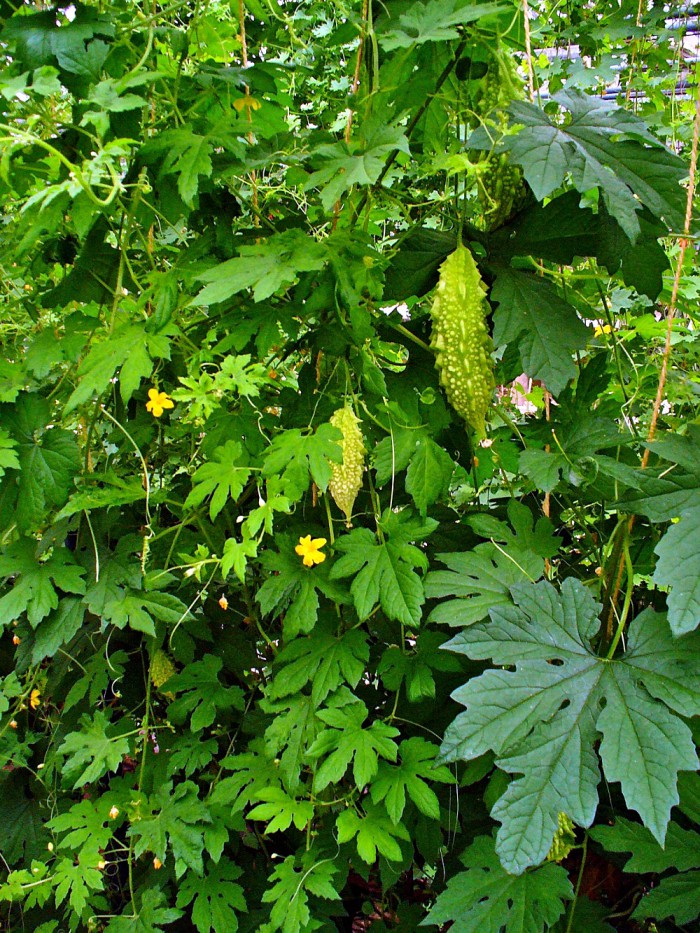Dies ist eine alte Version des Dokuments!
Momordica charantia L. - syn. Momordica sinensis Spreng.; Momordica indica L. - Cucurbitaceae
balsam pear, bitter cucumber, bitter croud, Balsambirne, Bittermelone, Bittergurke
Annual monoecious vine, up to 5m long, pantropical, also cultivated in temperate and tropical regions; stem and branches pubescent, endrils to 20cm long, simple; leaves ovate-reniform or suborbicular, 4-12cm, 5-7-partite, lobes ovate-oblong, veins palmate, margin crenate or irregularly lobed; male flowers solitary in axils of leaves, corolla yellow, stamens 3; female flowers solitary, ovary fusiform, densely verrucose; stigmas expanded, 2-lobed; fruit orange when mature, fusiform or cylindric, 10-20 cm, verrucose; seeds numerous, oblong. „The fruit is used as a vegetable; all parts of the plant are used medicinally.“ http://www.efloras.org/florataxon.aspx?flora_id=2&taxon_id=200022698
„The fruit is most often eaten green, or as it is beginning to turn yellow. At this stage, the fruit's flesh is crunchy and watery in texture, similar to cucumber, chayote or green bell pepper, but bitter. The skin is tender and edible. Seeds and pith appear white in unripe fruits; they are not intensely bitter and can be removed before cooking.“ https://en.wikipedia.org/wiki/Momordica_charantia
„Bioguided fractionation of the methanol extract of Momordica charantia dried gourds led to the isolation of cucurbitane triterpenoids… in order to evaluate the contribution of the cucurbitane triterpenoids of the ether fraction of M. charantia methanol extract to in vivo anti-diabetic effects, the major compounds, 5β,19-epoxy-3β,25-dihydroxycucurbita-6,23(E)-diene, and 3β,7β,25-trihydroxycucurbita-5,23(E)-dien-19-al have been tested and have shown blood hypoglycaemic effects in the diabetes-induced male ddY mice strain at 400 mg/kg. The two aglycones of charantin did not show any hypoglycaemic effects. Our finding is the first demonstration that major pure cucurbutanoid compounds of M. charantia have in vivo hypoglycaemic effects.“
[Momordica charantia constituents and antidiabetic screening of the isolated major compounds., Harinantenaina, L., Tanaka, M., Takaoka, S., Oda, M., Mogami, O., Uchida, M., Asakawa, Y., Chemical and Pharmaceutical Bulletin, 54(7), 2006, 1017-1021]
„Although momordica charantia is commonly used in traditional medical practices, along with research suggesting its benefits for people with type 2 diabetes, the current evidence does not warrant using the plant in treating this disease… Three trials showed no significant differences between momordica charantia and placebo or antidiabetic drugs (glibenclamide and metformin) in the blood sugar response… Adverse effects were mostly moderate, including diarrhoea and abdominal pain… Further studies are needed to assess the quality of the various momordica charantia preparations as well as to further evaluate its use in the diet of diabetic people.“
[Momordica charantia for type 2 diabetes mellitus., Ooi, C.P., Yassin, Z., Hamid, T.A., The Cochrane Library, 2012] http://www.update-software.com/BCP/WileyPDF/EN/CD007845.pdf

Momordica charantia CC BY-SA 3.0, Author: H. Zell https://commons.wikimedia.org/wiki/File:Momordica_charantia_001.JPG#/media/File:Momordica_charantia_001.JPG
